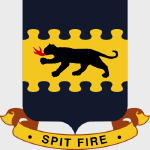Hobby Master HA8517 USAAF North American P-51C Mustang Fighter - "Alice-Jo", Captain Wendell Pruitt, 302nd Fighter Squadron, 332nd Fighter Group, Ramitelli, Italy, 1944 (1:48 Scale)
"With engine trouble, I was alone, trying to catch up with our Group near Strasbourg. I saw seven 109s pass beneath me, a group of four followed by three, one of which was smoking. I called for help then dove on the one that was smoking, firing from 600 yards to 100 yards when the Hun went into the deck and exploded. I then turned to the one on the left which also exploded as he hit the deck. In the meantime, two got on my tail and I went into a tight orbit. At that time, six P-47s appeared and drove them off. I then turned on the third 109 which tried to do a short landing on an airdrome. He hit the ground with his wing flying off as I ran to avoid the flak. My R/T was out so I headed for home. I soon encountered a Ju-88 and as I fired on it three chutes appeared and the plane exploded."
- Captain Ted Lines, September 10th, 1944
 No other aircraft of WWII could fly as high, go as far, or fight as hard as the famed Mustang. Piloted by a record 281 Aces, this agile and ferocious dogfighter tallied more kills than any other Allied airplane. As the bombers of the Eighth Air Force fought their way deep into Hitler's Germany, it was the Mustang that cleared the skies of Luftwaffe fighters. The powerful Rolls-Royce Merlin engine gave the Mustang a speed of 445 mph. Re-styled with an aerodynamic bubble canopy for greater visibility, and outfitted with 6 fast-firing .50 caliber machine guns, the P-51 became the best fighter of the war.
No other aircraft of WWII could fly as high, go as far, or fight as hard as the famed Mustang. Piloted by a record 281 Aces, this agile and ferocious dogfighter tallied more kills than any other Allied airplane. As the bombers of the Eighth Air Force fought their way deep into Hitler's Germany, it was the Mustang that cleared the skies of Luftwaffe fighters. The powerful Rolls-Royce Merlin engine gave the Mustang a speed of 445 mph. Re-styled with an aerodynamic bubble canopy for greater visibility, and outfitted with 6 fast-firing .50 caliber machine guns, the P-51 became the best fighter of the war.
The P-51K Mustang was essentially a P-51D with a different propeller. With war production at max capacity in Inglewood, NAA added P-51 production at their Dallas Texas plant starting with the P-51B. The new designation of the B models built in Dallas was P-51C.
When the P-51D began production, once again the Dallas plant was needed. Unlike the B models, when the D models were built in Dallas, their designation of "D" was kept. They were identified as built from the Dallas plant with the "NT" suffix. So a -5 block of a D model Mustang built in Dallas would be a P-51D-5NT. These were identical to a P-51D-5NA, built in Inglewood, Ca.
Pictured here is a 1:48 scale replica of a USAAF North American P-51C Mustang fighter that was nicknamed "Alice-Jo", and piloted by Captain Wendell Pruitt, who was attached to the 302nd Fighter Squadron, 332nd Fighter Group, then deployed to Ramitelli, Italy, during 1944.
Back Order! Return to stock date February 2025
Dimensions:
Wingspan: 8-1/2-inches
Length: 7-1/2-inches
Release Date: November 2024
 Historical Account: "Red Tails" - Wendell Pruitt, already a licensed pilot, enlisted in the Army Air Corps Cadet Flying Program in Tuskegee, Alabama, eventually graduating and being commissioned as a second lieutenant on December 11th, 1942.
Historical Account: "Red Tails" - Wendell Pruitt, already a licensed pilot, enlisted in the Army Air Corps Cadet Flying Program in Tuskegee, Alabama, eventually graduating and being commissioned as a second lieutenant on December 11th, 1942.
After graduating from flight school at Tuskegee, Pruitt was assigned to the 332nd Fighter Group, then stationed in Michigan. The 332nd was transferred to the Mediterranean theater in late 1943 where Pruitt flew the P-47 Thunderbolt.
In June 1944, Pruitt and his occasional wingman, 1st Lt. Gwynne Walker Peirson landed direct hits on an enemy destroyer that sank at Trieste harbor in northern Italy. He received the Distinguished Flying Cross for this action. Thereafter, the 332nd flew the P-51 Mustang as their primary fighter aircraft.
Pruitt teamed with Lee Archer to form the famed "Gruesome Twosome", the most successful pair of Tuskegee pilots in terms of air victories. The "Gruesome Twosome" are featured in a History Channel show entitled Dogfights: Tuskegee Airmen. Pruitt flew seventy combat missions, was credited with three enemy kills, and reached the rank of captain.
Overall, Pruitt was one of the Tuskegee Airmen pilots with at least three confirmed kills during World War II.





 Tuskegee Airmen P-51 Mustang
Tuskegee Airmen P-51 Mustang 


